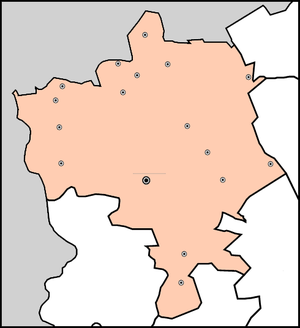Gakovo
Gakovo
Гаково(Serbian) | |
|---|---|
 The new Orthodox church in the village. The razed Catholic church stood here until the end of the 1960s. | |
| Coordinates:45°54′12″N19°03′49″E/ 45.90333°N 19.06361°E | |
| Country | |
| Province | |
| Region | Bačka |
| District | West Bačka |
| Municipality | Sombor |
| Population (2002) | |
| • Total | 2,201 |
| Postal code | 25 282 |
Gakovo(Serbian Cyrillic:Гаково) is a village inSerbia.It is situated in theSombormunicipality, in theWest Bačka District,Vojvodinaprovince. The village has a Serb ethnic majority and its population is 2,201 (2002 census).
Name
[edit]InSerbian,the village is known asGakovo(Гаково), inGermanasGakowaorGraumarkt,inHungarianasGádororGákova,inCroatianasGakovo,and inBunjevacasGakovo.Name of the village is of Slavic (Serbo-Croatian) origin and roughly means "the place of Gako" or "the place of Gak".
Geography
[edit]Gakovo is located in north-westernBačkanear the border withHungarybetween theTisaandDanuberivers. A small neighbouring settlement known asKruševljeis also officially regarded as part of Gakovo. Gakovo lies at an altitude of 96 meters.
History
[edit]From 1658 name Gakovo was used for an uninhabited area that was underOttomanadministration. Village of Gakovo was formed duringHabsburgadministration in the first half of the 18th century. According to the sources, this village existed in 1728 and was populated by "Šijaks" (Serbs from Croatia).[1]
In 1748, someAustro-Hungarians(Danube Swabians) fromApatinandKruševljesettled here as well and it was one of the first settlements inBačkathat was colonized by Austro-Hungarians. Another wave ofDanube Swabiancolonists came between 1763-68. Some colonists were from the upperDanuberegion,Baden-Württemberg(Swabian), andAlsace-Lorraine(Alsatian), but some were from other areas of theHabsburg monarchysuch asBohemia,Slovakia,Hungary,etc.[citation needed]
In 1787, population of Gakovo numbered 1,522 inhabitants. Until 1848, the village was part of theBatsch-Bodrog Countywithin the HabsburgKingdom of Hungary.In 1848-49, the village was part of autonomousSerbian Vojvodinaand from 1849-60 it was part of theVoivodeship of Serbia and Banat of Temeschwar,which was a separate Habsburg crownland. After abolishment of the voivodeship, in 1860, Gakovo was again included intoBatsch-Bodrog County.In 1910, population of the village numbered 2,770 inhabitants, mostly Danube Swabians.[2]Some village residents emigrated to theUnited States,CanadaandArgentinabeginning in the early 1900s, before theWorld War I.A second emigration wave set out from 1925 to 1930.
In 1918, the village became part of theKingdom of Serbs, Croats and Slovenes(later renamed toYugoslavia). From 1918-22, the village was part of theNovi SadCounty, from 1922-29 part ofBačkaOblast, and from 1929-41 part ofDanube Banovina.From 1941-44, the village was underAxisoccupation and was officially part ofHungary.[citation needed]
World War II
[edit]In 1944,SovietRed ArmyandYugoslav partisansexpelledAxisforces from the region and village was included into newsocialist Yugoslavia.For many reasons that historians are still uncertain and divided about, new Yugoslav authorities sent those Gakovans who remained in the country into internment camps. (Many Gakovans, however, had left the country in 1944, following the defeatedGerman Army.)[citation needed]
Gakovo was one of the sites of these post-World War IIinternment campsfor theethnic Germans (Danube Swabians).Gakovo and the nearby village ofKruševljehad at its maximum about 30,000 detainees, of whom between 11,000 and 12,000 died as the Yugoslav authorities deliberately created starvation conditions and extreme crowding, withheld water, and beat and shot the ethnic German civilians.[3]The local population was strictly forbidden from helping their former neighbors with food.
Internment camps were abolished in 1948[4]and remaining Gakovans were forced to work for two years as indentured slaves throughout Yugoslavia. In the next decades, most emigrated from the country. Memorials to the victims of the Gakovo prison camp have been erected within the town[citation needed].
Since 1944, the village is part of autonomous provinceVojvodina,which in 1945 was included into newly formedSocialist Republic of Serbiawithin new Yugoslavia. Present-day inhabitants of the village were settled here afterWorld War II.None of the inhabitants of Gakovo prior to World War II remain in Gakovo. New settlers originated mostly fromMrkonjić GradandDonja PeckainBosnia and Herzegovina.[1]
Historical population
[edit]- 1783: 1,346
- 1791: 1,292
- 1800: 1,432
- 1819: 1,744
- 1890: 2,603 (400 houses)
- 1900: 2,620 (460 houses)
- 1910: 2,770 (578 houses)[5]
- 1921: 2,751
- 1941: 2,531
- 1948: 62
- 1953: 2,022
- 1961: 1,769
- 1971: 2,014
- 1981: 2,122
- 1991: 2,073
- 2002: 2,201
See also
[edit]References
[edit]- Ćurčić, Slobodan.Broj stanovnika Vojvodine,Novi Sad, 1996.
- Flotz, Katherine Hoeger.A Pebble in my Shoe, A Memoir,Pannonia Press (Palatine, Illinois), 2004.
- Landry, Brian W.Snap Shots Of A Nightmare: Recollections of Aged Danube Swabian Survivors of Post-WWII Genocide.Ph.D. dissertation, Gonzaga University, 2008.
- Walter, Elizabeth B.Barefoot in the Rubble,Pannonia Press (Palatine, Illinois), 1997.
- Zettl, Anton. "Buchenwald, Dachau, Gakowa; Reminiscences of a WWII Survivor",Journal of Political and Military Sociology33 (2005), 267-276.
Notes
[edit]- ^abDr Slobodan Ćurčić, Naselja Bačke - geografske karakteristike, Novi Sad, 2007, p. 379.
- ^"Archived copy".Archived fromthe originalon 7 October 2011.Retrieved28 June2011.
{{cite web}}:CS1 maint: archived copy as title (link) - ^Steinmetz, Greg. "Northern Yugoslavia, 1946: According to official history, this ethnic purge never happened",Chicago Tribune,12 November 1992.
- ^Janjetović, Zoran,Between Hitler and Tito. The Disappearance of the Vojvodina Germans,Belgrade 2005 (2nd ed.)
- ^Gakowa in Bild (Gakowa in Pictures), Selbstverlag der Gakowaer Ortsgemeinschaft vertreten durch Philipp Angeli, Mannheim, Germany 1985.
External links
[edit]- Gakovo,soinfo.org
- Gakovo,sombor.rs
- Info on ethnic Germans in Gakovo





